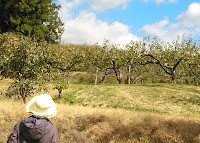October 28, 2020
Persimmons enlivening Japanese as autumn air deepens toward winter
As autumn deepens day by day in many parts of Japan, Japanese see shops' shelves filled with a various kind of fruits. Among them are persimmons, known as the king of fruits in autumn in Japan.Persimmons are loved by Japanese for their refined sweetness.
Many kinds of persimmons are sweet themselves. "Shibugaki" persimmons are bitter and cannot be eaten as they are, but they sweeten when they are dried with the gentle autumn sunlight.
A landscape in which rods with lots of shibugaki persimmons tied to each other by strings are hung in front of farmers' houses is a traditionally observed scene in Japan's autumn.
Customers are seen looking for their favorite kinds of persimmons at farmers' markets around this time of the year.
This year, they have to pay attention to themselves while shopping to keep away from the covid-19 infection. Persimmons contained in transparent plastic bags are on the shelves, so they may not be contaminated. This reminds customers that they live in a quite new living environment with the coronavirus.
The tall tower of Horyuji Temple far ahead,
the sound of its bell comes to me, when I bite a persimmon.
(A personal translation)
This is a haiku short poem made by Natsume Soseki, a distinguished novelist who was active from the middle of the Meiji era. Soseki, a scholar-turned writer, left many famous novels, which are still read by Japanese.
Horyuji, a buddhist temple in Nara, Japan's ancient capital, was originally built in the late 6th century.
Its five-story tower is the oldest existing wooden structure in Japan, so the image of the time-honored structure makes Japanese feel like they are back in an ancient, rustic atmosphere.
Many Japanese have spent boring, painful days this year, trying to be uninfected by the deadly corona virus. Persimmons are expected to give them time to refresh themselves to live a new normal life in the days ahead.




No comments:
Post a Comment